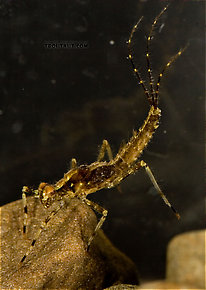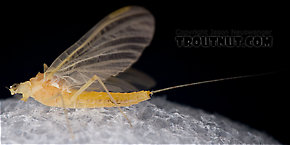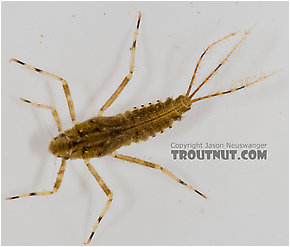Blog & Latest Updates
Fly Fishing Articles
Insects by Common Name


Mayfly Species Penelomax septentrionalis
Taxonomic Navigation -?-
Kingdom
Animalia (Animals)
» Phylum
Arthropoda (Arthropods)
» Class
Insecta (Insects)
» Order
Ephemeroptera (Mayflies)
» Genus
Penelomax
» Species septentrionalis
This species was overlooked in the fly-fishing literature for many years. The first details appear in Fly-Fishing Pressured Water, which states that this species (formerly called Ephemerella septentrionalis) sometimes supports hatches of Ephemerella invaria. Ernest Schwiebert's Nymphs Volume I: The Mayflies: The Major Species seconds that claim, suggesting that it generates fishable hatches which may go unnoticed due to confusion with both Ephemerella invaria and Ephemerella dorothea. However, the long legs, thin dorsal (Dorsal: Top.) stripe, and more vivid color make it easy to tell them apart upon close inspection.
Where & When
There are records of this species from Tennessee north into Ontario and Quebec. They begin in early May near the southern end of their range, and continue into midsummer in Canada. Expect them from mid-May through early June in the popular fly fishing waters of Pennsylvania and New York, from the limestone spring creeks to the freestone Catskill and Poconos waters. Their timing coincides with the more common and similar Ephemerella invaria.
Hatching Behavior
Time Of Day (?): Late afternoon early in the season; twilight later on
Spinner Behavior
Time Of Day: Twilight
Nymph Biology
Substrate: Weedy stretches of stream
These nymphs may be most abundant in very small streams, but they are known from larger rivers as well, and I have collected them from the main stem of the Delaware.Pictures of 3 Mayfly Specimens in the Species Penelomax septentrionalis:
Penelomax septentrionalis Mayfly Nymph View 12 PicturesThis is surely the most distinctive-looking species in Ephemerellidae. I like the rugged, spindly look. If mayflies made movies, Penelomax septentrionalis would probably play the supervillain.
View 12 PicturesThis is surely the most distinctive-looking species in Ephemerellidae. I like the rugged, spindly look. If mayflies made movies, Penelomax septentrionalis would probably play the supervillain.
Maybe I should take a break and get something to eat.
 View 12 PicturesThis is surely the most distinctive-looking species in Ephemerellidae. I like the rugged, spindly look. If mayflies made movies, Penelomax septentrionalis would probably play the supervillain.
View 12 PicturesThis is surely the most distinctive-looking species in Ephemerellidae. I like the rugged, spindly look. If mayflies made movies, Penelomax septentrionalis would probably play the supervillain.Maybe I should take a break and get something to eat.
Collected May 13, 2007 from the Delaware River in New York
Added to Troutnut.com by Troutnut on May 18, 2007
Added to Troutnut.com by Troutnut on May 18, 2007
Female Penelomax septentrionalis Mayfly Dun View 10 PicturesI'm confident this dun belongs to septentrionalis, because her legs are just too long for any other Ephemerellid, and her unusual mid-dorsal (Dorsal: Top.) stripe matches those of two easily identified nymphs I collected some miles downstream.
View 10 PicturesI'm confident this dun belongs to septentrionalis, because her legs are just too long for any other Ephemerellid, and her unusual mid-dorsal (Dorsal: Top.) stripe matches those of two easily identified nymphs I collected some miles downstream.
This really pretty mayfly was in kind of bad shape when I found it crippled on the surface, and bouncing around in my container with a bunch of green drakes didn't help.
 View 10 PicturesI'm confident this dun belongs to septentrionalis, because her legs are just too long for any other Ephemerellid, and her unusual mid-dorsal (Dorsal: Top.) stripe matches those of two easily identified nymphs I collected some miles downstream.
View 10 PicturesI'm confident this dun belongs to septentrionalis, because her legs are just too long for any other Ephemerellid, and her unusual mid-dorsal (Dorsal: Top.) stripe matches those of two easily identified nymphs I collected some miles downstream.This really pretty mayfly was in kind of bad shape when I found it crippled on the surface, and bouncing around in my container with a bunch of green drakes didn't help.
Collected June 1, 2007 from the West Branch of the Delaware River in New York
Added to Troutnut.com by Troutnut on June 4, 2007
Added to Troutnut.com by Troutnut on June 4, 2007
Penelomax septentrionalis Mayfly Nymph View 3 Pictures
View 3 Pictures
 View 3 Pictures
View 3 PicturesCollected May 13, 2007 from the Delaware River in New York
Added to Troutnut.com by Troutnut on May 18, 2007
Added to Troutnut.com by Troutnut on May 18, 2007
Recent Discussions of Penelomax septentrionalis
Anyone know more about Ephemerella septentrionalis? 11 Replies »
Posted by Troutnut on May 18, 2007
Last reply on Jul 18, 2011 by Oldredbarn
I found about one sentence on these in Gonzo's book, and haven't seen them mentioned anywhere else in fly fishing literature. Nor is any of the scientific literature I have on them particularly interesting (just descriptions). Now that I've collected a few and see what unique-looking nymphs they've got, I'm really curious about them.
ReplyYour Thoughts On Penelomax septentrionalis:
Top 10 Fly Hatches
Top Gift Shop Designs
Eat mayflies.
Top Insect Specimens
Miscellaneous Sites
Troutnut.com is copyright © 2004-2024 Jason
Neuswanger (email Jason). See my FAQ for information about use of my images.
 privacy policy
privacy policy
